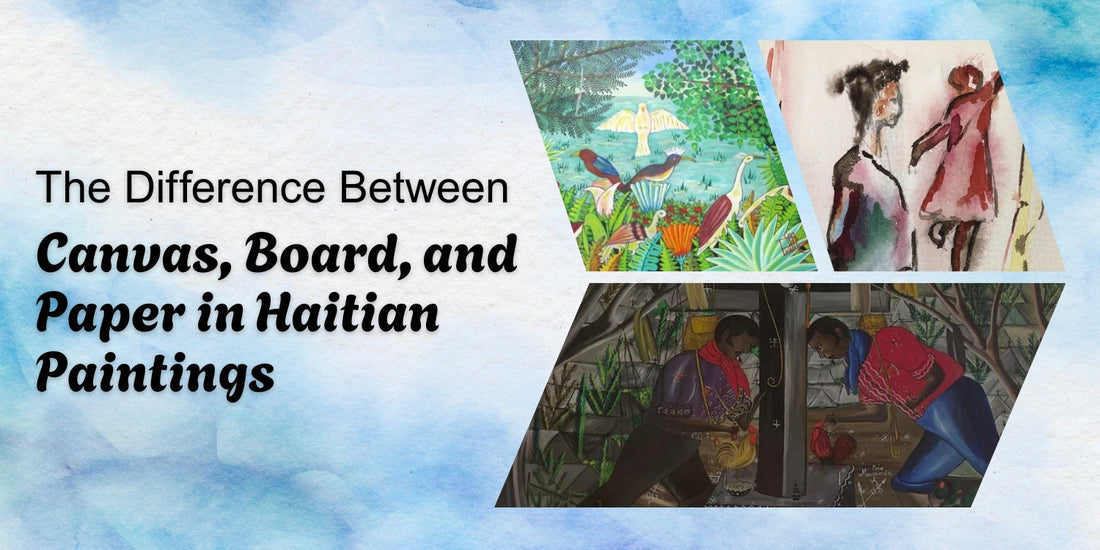
The Difference Between Canvas, Board, and Paper in Haitian Paintings
Today's modern artists possess an impressive array of tools, including various painting surfaces, brushes, and materials. In stark contrast, artists faced formidable challenges nearly a century ago. Primitive Haitian artists displayed their talents on walls and scraps of fabric, boldly pushing the limits of their creativity.
They experimented with a range of materials, including wood and metal, crafting brushes from sticks and crushed stones with remarkable ingenuity. It’s essential to recognize that many Haitian artists in the early stages of their development deliberately chose affordable materials for their creations. A standout example is Hector Hyppolite, a key figure during the Haitian Renaissance who famously utilized chicken feathers in his early works.
Other noteworthy artists, including Jacques-Enguerrand Gourgue and Philomé Obin, similarly embraced cost-effective materials. Their creative journeys evolved significantly once they joined the Centre d’Art, gaining access to professional supplies that elevated their artistic expression.
Canvas, Board, and Paper Surfaces for Haitian Artwork: Before diving into the distinctions between canvas, board, and paper artwork, it’s vital to examine each surface individually.
What Are the Differences Between Canvas, Board, and Paper in Haitian Artwork?
Haitian paintings demand attention with their vibrant colors, unique styles, and rich cultural heritage. Artists decisively choose from various mediums—canvas, board, and paper—to create their masterpieces. Each medium possesses distinct characteristics, advantages, and challenges that directly shape the final artwork.
1. Canvas Artwork: A Classic Choice: Canvas is the definitive choice for Haitian paintings, especially for larger works. It provides a durable and flexible surface that withstands the test of time. The textured, woven appearance of the canvas adds depth and enhances the artwork's overall impact.
-
Advantages: Canvas is ideal for large-scale paintings, and its texture adds an exceptional quality to the piece. Additionally, it is cost-effective for shipping.
- Challenges: However, canvas artwork can stretch or warp over time, necessitating careful framing or stretching to preserve its integrity.
2. Board Artwork: A Sturdy Alternative: Artwork on board, made from wood or composite materials, offers a robust and reliable surface for painting. Many Haitian artists confidently prefer board for its unmatched stability and strong resistance to warping. Boards, often referred to as canvas boards or panels, consist of paper with primer applied to a rigid surface such as wood or cardboard.
- Advantages: Board artwork provides a smooth, stable surface that allows for precise detailing and meticulous brushwork.
- Challenges: On the downside, board artwork can be heavier and more costly than canvas, often lacking the textural appeal that certain artists desire.
3. Paper Artwork: A Delicate Medium: Paper artwork has emerged as the dominant surface for contemporary paintings. Artists have access to a wide variety of paper types tailored to their specific textural needs. Notably, canvas paper mimics the feel of traditional canvas, while options such as pastel paper, watercolor paper, and mixed media paper offer impressive versatility. While less frequently used for Haitian paintings, paper can produce stunning results when applied skillfully. Artists leverage paper for smaller, more delicate pieces or to create refined sketches and studies.
-
Advantages: Paper artwork is lightweight and versatile, making it easy to store and transport.
- Challenges: Nonetheless, paper artwork is prone to tearing and damage, making it unsuitable for large-scale or heavily textured works.
How to Choose the Right Medium?
When selecting a medium for Haitian artwork, artists must consider critical factors such as desired texture, durability, and overall aesthetic. Each option—canvas, board, or paper—offers unique benefits and challenges, ultimately reflecting the artist's vision and style.
Preservation and Conservation: Regardless of the chosen medium, preserving and conserving Haitian artwork is paramount for maintaining its beauty and longevity. Proper storage, handling, and framing are crucial to safeguard these valuable artworks against damage and deterioration.
The distinctions between canvas, board, and paper in Haitian art are not only straightforward but also essential to understand. By recognizing these differences, art enthusiasts and collectors can cultivate a deeper appreciation for the craftsmanship and artistry that define these extraordinary works. Whether you are an established collector or just starting your exploration of Haitian art, understanding the medium will undoubtedly enhance your appreciation and enjoyment of these remarkable creations.
Explore an extensive collection of stunning Haitian artwork on boards, canvases, and paper at Myriam Nader's online art gallery in New York. From affordable pieces to investment-worthy masterpieces, our curated selection caters to all tastes and budgets.
Browse our collection today and find your perfect piece of Haitian art!
Contact us: myriamnader2007@aol.com









